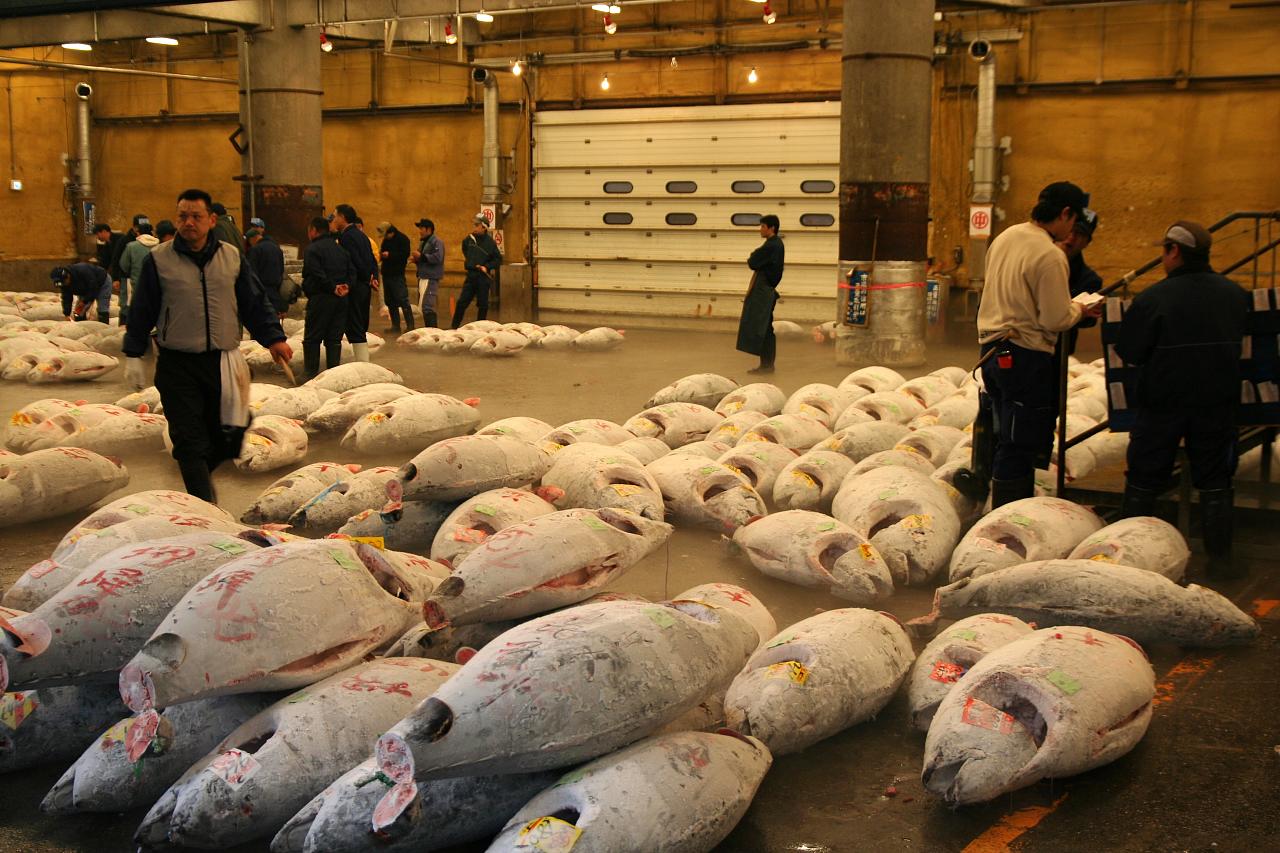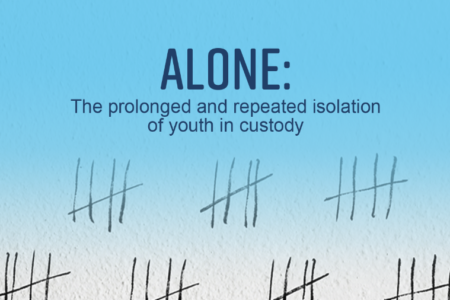Opinion: Aquacalypse Now -- The End of Fish
From renowned marine biologist Daniel Pauly, a fascinating analysis of our collapsed global fisheries and a revolutionary vision for their future; courtesy of The Narwhal
This is an excerpt adapted with permission of the publisher from the book Vanishing Fish by Daniel Pauly, published May 28, 2019 by Greystone Books.
Our oceans have been the victims of a giant Ponzi scheme, waged with Bernie Madoff–like callousness by the world’s fisheries. Beginning in the 1950s, as their operations became increasingly industrialized, with onboard refrigeration, acoustic fish-finders, and, later geographic positioning systems, or GPS, the fishing fleets first depleted populations of cod, hake, flounder, sole, and halibut in the Northern Hemisphere. As the abundance of those fish declined, the fleets moved southward, to the coasts of developing countries, and, ultimately, all the way to the shores of Antarctica, searching for icefishes and rock cods, and finally for the small, shrimp-like krill.
As the bounty of coastal waters dropped, fisheries moved farther offshore, to deeper waters. And, finally, as the larger fish began to disappear, boats began to catch smaller, uglier fish that had never before been considered fit for human consumption. Many were renamed so that they could be more easily marketed. The suspicious slimehead became the delicious orange roughy, while the worrisome Patagonian toothfish became the wholesome Chilean seabass. Others, like the homely hoki, were cut up so that they could be sold sight unseen as fish sticks and filets in fast-food restaurants and the frozen-food aisle.
The scheme was carried out by nothing less than a fishing-industrial complex — an alliance of corporate fishing fleets, lobbyists, parliamentary representatives and fisheries economists. By hiding behind the romantic image of the small-scale, independent fisher, they secured political influence and government subsidies far in excess of what would be expected, given their minuscule contribution to the GDP of advanced economies — in the United States, even less than that of the hair salon industry. In Japan today, huge, vertically integrated conglomerates, such as Taiyo or the better-known Mitsubishi, lobby their friends in the Japanese Fisheries Agency and the Ministry of Foreign Affairs to help them gain access to the few remaining plentiful tuna populations, such as those in the waters surrounding South Pacific countries. Beginning in the early 1980s, the United States, which had not traditionally been much of a fishing country, began heavily subsidizing U.S. fleets, producing its own fishing-industrial complex, dominated by large processors and retail chains.
Today, the world’s governments provide over US$30 billion in subsidies each year — about one-third of the value of the global catch — that keep fisheries going, even when they have overexploited their resource base. As a result, there are between two and four times as many boats as the annual catch requires; yet the funds to “build capacity” keep coming.
The jig, however, is nearly up. In 1950, the Food and Agriculture Organization of the United Nations (FAO) estimated that, globally, we were catching about 17 million metric tonnes annually of fish (cod, mackerel, tuna, etc.) and invertebrates (lobster, squid, clams, etc.). Reported marine catches peaked at about 90 million metric tonnes per year in the mid-1990s, and they have been declining since. Much like Madoff’s infamous operation, which required a constant influx of new investments to generate “revenue” for past investors, the global fishing-industrial complex has required a constant influx of new “stocks” to continue operating. Instead of restricting its catches so that fish can reproduce and maintain their populations, the industry has simply fished until fish populations were depleted and then moved on to new or deeper waters and to smaller and stranger fish. And, just as a Ponzi scheme will collapse once the pool of potential investors has been drained, so too will the fishing industry collapse as the oceans are drained of life.
Our impacts on the ocean
Unfortunately, it is not just the future of the fishing industry that is at stake but also the continued health of the world’s largest ecosystem. While the climate crisis regularly gathers front-page attention, people — even those who profess great environmental consciousness — continue to eat fish as if fishing were a sustainable practice. But eating a tuna roll at a sushi restaurant should be considered no more environmentally benign than driving a Hummer or harpooning a manatee. In the past 50 years, we have reduced the populations of large commercial fish, such as bluefin tuna, Atlantic cod and other favourites, by a staggering 90 per cent. One study, published in the prestigious journal Science, forecast that by 2048 all commercial fish populations will have “collapsed,” meaning that they will be generating 10 per cent or less of their peak catches. Whether or not the particular year, or even decade, of the peak catch is correct, one thing is clear: fish are in dire peril, and, if they are, then so are we.
Eating a tuna roll at a sushi restaurant should be considered no more environmentally benign than driving a Hummer or harpooning a manatee.
The extent of the fisheries’ Ponzi scheme eluded government scientists for many years. They had long studied the health of fish populations, of course, but typically laboratories would focus only on the species in their country’s waters. Moreover, those studying a particular species in one country would communicate only with those studying that same species in another. Thus, they failed to notice an important pattern: popular species were sequentially replacing each other in the catches that fisheries were reporting, and, when a species faded, scientific attention shifted to the replacement species. At any given moment, scientists might acknowledge that one-half or two-thirds of fisheries were being overfished, but when the abundance of a particular fish had strongly declined, it was simply removed from the denominator of the fraction. For example, the Hudson River sturgeon was not counted as overfished once it disappeared from New York waters; it simply became an anecdote in the historical record. The baselines just kept shifting, allowing us to continue blithely damaging marine ecosystems.
It was not until the 1990s that a series of high-profile scientific papers demonstrated that we needed to study, and mitigate, fish depletions at the global level. These studies showed that phenomena previously observed at local levels — for example, the disappearance of large species from fisheries’ catches and their replacement by smaller species — were also occurring globally. It was a realization akin to understanding that financial meltdowns are due not to the failure of a single bank but rather to the failure of the entire banking system. And it drew a lot of controversy.
Two types of scientific responses
The notion that fish are globally imperilled has been challenged in many ways — perhaps most notably by fisheries biologists, who have questioned the facts, the tone and even the integrity of those making such allegations. Marine ecologists are concerned mainly with threats to the diversity of the ecosystems they study, and so, they frequently work in concert with environmental nongovernmental organizations (NGOs) and are often funded by philanthropic foundations. In contrast, fisheries biologists traditionally work for government agencies, like the National Marine Fisheries Service within the U.S. Department of Commerce, or as consultants to the fishing industry, and their chief goal is to protect fisheries and the fishers they employ. I was trained as a fisheries biologist in Germany, and, while they would dispute this, the agencies for which many of my former classmates work clearly have been captured by the industry they are supposed to regulate. Thus, there are fisheries scientists who, for example, write that cod have “recovered” or even “doubled” their numbers when, in fact, they have increased merely from one per cent to two per cent of their original abundance in the 1950s or earlier.
The difficulty lies in forcing the fishing-industrial complex to catch fewer fish so that populations can rebuild.
Yet despite their different interests and priorities — and despite their disagreements about the “end of fish” — marine ecologists and fisheries scientists both want there to be more fish in the oceans. This is partly because both are scientists, who are expected to concede when confronted with strong evidence. And, as with global warming, the evidence is overwhelming: fish populations are declining in most parts of the world. Ultimately, the important rift is not between these two groups of scientists but between the public, which owns the sea’s resources, and the fishing-industrial complex, which needs fresh capital for its Ponzi scheme. The difficulty lies in forcing the fishing-industrial complex to catch fewer fish so that populations can rebuild.
It is essential that we do so as quickly as possible because the consequences of an end to fish are frightening. To some Western countries, an end to fish might simply seem like a culinary catastrophe, but for half a billion people in developing countries, particularly in Africa and South and Southeast Asia, fish are the main source of animal protein. What’s more, fisheries are a major source of livelihood for hundreds of millions of people. A World Bank report found that the income of the world’s 30 million small-scale fishers is shrinking. The decrease in catch has also dealt a blow to a prime source of foreign-exchange earnings, which impoverished countries — ranging from Senegal in West Africa to the Solomon Islands in the South Pacific — rely on to support their imports of staples such as rice.
The oceans’ responses
The end of fish would disrupt marine ecosystems to an extent that we are only now beginning to appreciate. Thus, the removal of small fish in the Mediterranean to fatten bluefin tuna in pens is causing the “common” dolphin to become exceedingly rare in some areas, and local extinction is probable. Other marine mammals and seabirds are similarly affected in various parts of the world. Moreover, the removal of top predators from marine ecosystems has cascading effects, leading to an increase in jellyfish and other gelatinous zooplankton and to the gradual erosion of the food web within which fish populations are embedded. This is what happened at the turn of this century off the coast of southwestern Africa, where an upwelling ecosystem similar to that off California, previously dominated by fish such as hake and sardines, has been taken over by millions of tonnes of jellyfish.
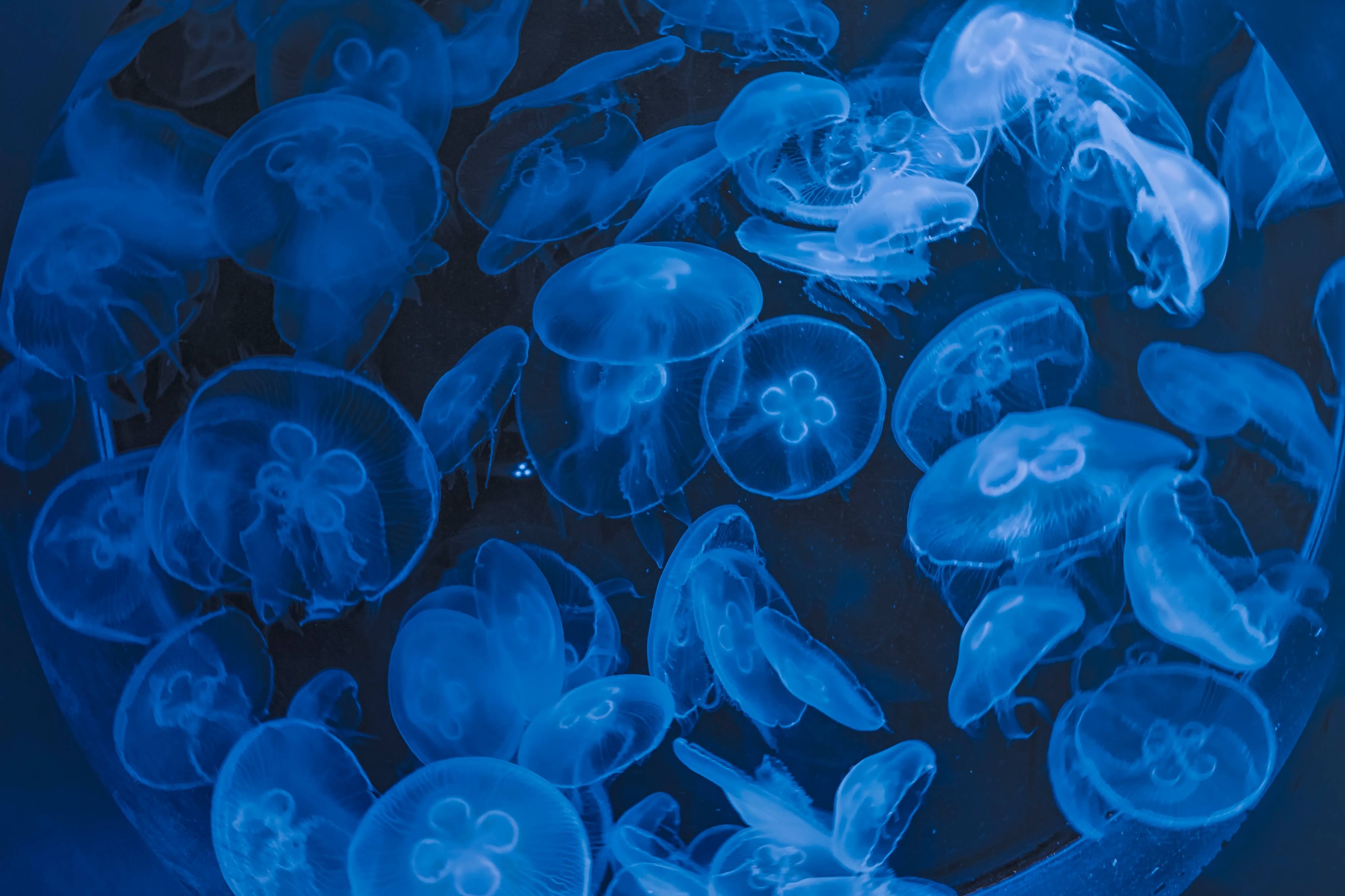
Jellyfish population outbursts are also becoming more frequent in the northern Gulf of Mexico, where the fertilizer-laden runoff from the Mississippi River fuels uncontrolled algal blooms. The dead algae then fall to a sea bottom from which shrimp trawling has raked all animals capable of feeding on them, and so they rot, causing huge “dead zones.” Similar phenomena — which only jellyfish seem to enjoy — are occurring throughout the world, from the Baltic Sea to the Chesapeake Bay, and from the Black Sea in southeastern Europe to the Bohai Sea in northeastern China. Our oceans, having nourished us since the beginning of the human species some 150,000 years ago, are now turning against us. That dynamic will only grow more antagonistic as the oceans become warmer and more acidic because of climate change. Fish are expected to suffer mightily from global warming, making it essential that we preserve as great a number of fish and fish species as possible so that those that are able to adapt are around to evolve and propagate the next generations of marine life. In fact, new evidence tentatively suggests that large quantities of fish biomass could actually help attenuate ocean acidification. In other words, fish could help save us from the worst consequences of our own folly — yet we are killing them off. The jellyfish-ridden waters we are seeing now may be only the first scene in a watery horror show.
The roles of governments
To halt this slide toward a marine dystopia, government intervention is required. Regulatory agencies must impose quotas on the amount of fish caught in any given year, and the way they structure such quotas is very important. For example, simply permitting all fisheries to catch a given aggregate number of fish annually results in a wasteful build-up of fleets and vessels as fisheries race to grab as large a share of the quota as possible before their competitors do. Such a system may protect the fish, but it is economically disastrous: the entire annual quota is usually landed in a short period, leading to temporary oversupply, which, in turn, leads to low prices. The alternative is to limit the number of fishers, with those retaining “access privileges” being able to catch their assigned fraction of the overall quota whenever they want, without competing against other fishers. Such individual quotas lead to less overall fishing effort and, hence, larger profit in the fishery.
Unfortunately, most fisheries economists, fixated solely on corporate short-term profits, argue that for such a system to work, access privileges must be handed out for free, be held in perpetuity, and be transferable (i.e., sellable and buyable like any other commodity). They call this construct “fishing rights,” or “individual transferable quotas.” However, there is no reason why a government should not auction off quotas with access privileges. The highest bidder would secure the right to a certain percentage of the quota, and society as a whole would benefit from providing private access to a public resource. This would be similar to ranchers paying for the privilege to graze their cattle on federal lands. Grazing “rights,” on the other hand, would simply give ownership of public land to ranchers, which is something few would consider.
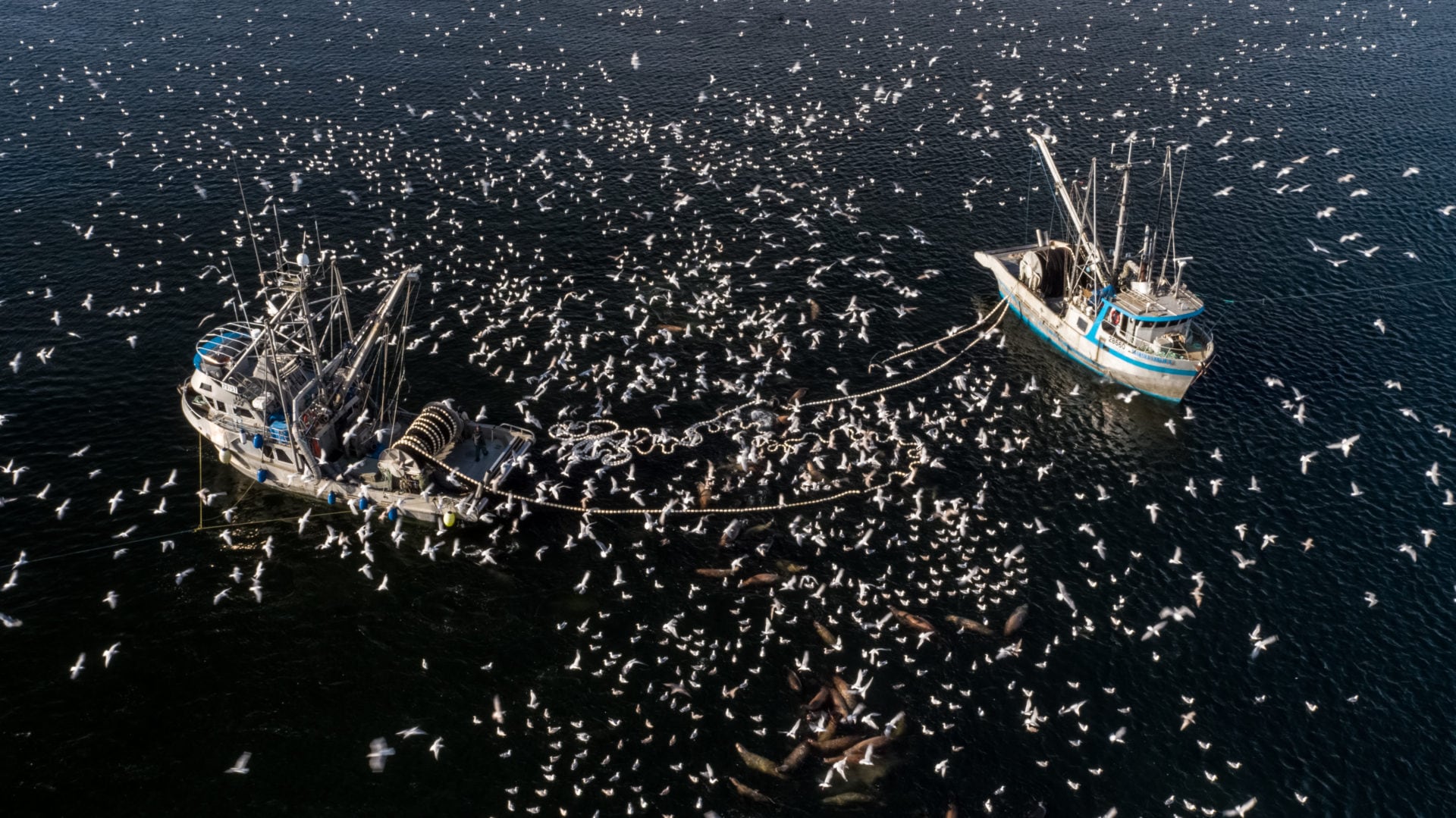
Herring fishing boats and flocks of seabirds on Georgia Strait, B.C. Photo: Pacific Wild
Some Pollyannas believe that aquaculture, or fish farming, can ensure the health of wild fish populations without government action — a notion supposedly buttressed by statistics of the FAO showing such rapid growth in aquaculture that more than 40 per cent of all “seafood” consumed now comes from farms. The problem with this argument is that China reports over 60 per cent of the world’s aquaculture production, and the FAO, which has been burned by inflated Chinese statistics before, expresses doubt about its stated production and growth rates.
Outside of China — where most farmed fish, such as carp, are freshwater vegetarians — aquaculture produces predominately carnivorous marine fish, like salmon, which are fed not only vegetal ingredients but also fishmeal and fish oil, which are obtained by grinding up perfectly edible herring, mackerel and sardines caught by what is coyly called “reduction fisheries.” Carnivore farming, which requires three to four pounds of smaller fish to produce one pound of a larger one, thus robs Peter to pay Paul. Aquaculture in the West produces a luxury product in global terms. To expect aquaculture to ensure that fish remain available — or, at least, to expect carnivore farming to solve the problem posed by diminishing catches from fisheries — would be akin to expecting that Enzo Ferrari’s cars rather than an emphasis on public transport can solve the gridlock in Los Angeles.
Others believe that fish populations can be rebuilt through consumer awareness campaigns that encourage buyers to make prudent choices. One such approach is to label seafood from fisheries deemed sustainable. In Europe, for example, consumers can look for the logo of the Marine Stewardship Council (MSC), a non-profit started by the World Wildlife Fund and Unilever, which has a large fish-trading division. At first, the MSC certified only small-scale fisheries, but lately, it has given its seal of approval to large, controversial companies. It has even begun to measure its success by the percentage of the world catch that it certifies. Encouraged by a Walton Foundation grant and Wal-Mart’s goal of selling only certified fish, the MSC is actually considering certifying reduction fisheries, with the consequence that Wal-Mart, for example, will be able to sell farmed salmon shining with the ersatz glow of sustainability. (Given the devastating pollution, diseases and parasite infestations that have plagued salmon farms in Chile, Canada and other countries, this “Wal-Mart strategy” will, in the long term, make the MSC complicit in a giant scam.) The other market-based initiative, prevalent in the United States, distributes wallet-sized cards designed to steer consumers toward fish that the group issuing the cards deems to have been caught sustainably. Their success is considerable if measured by the millions of cards given away, for example, by the Monterey Bay Aquarium, but assessing the impact on the fisheries is difficult. For one thing, the multitude of such cards leads to contradictions and confusion, as the same fish are assessed differently by different organizations. For example, ahi tuna (yellowfin) was once rated as “safe,” “questionable,” and “avoid” on the wallet cards issued by three different U.S. NGOs.
A bigger issue, however, is that these cards generate only “horizontal” pressure — that is, a group of restaurant-goers might chide each other for ordering the cod filet or might ask the overworked student who served them where the fish came from, but this pressure does not reach wholesalers, fleet operators or supermarket chains. “Vertical” pressure exerted by environmental NGOs on such decision-makers is far more effective. But, if that is true, why not directly pressure the government and legislators, since they are the ones who regulate the fisheries?
The fact is that governments are the only entities that can prevent the end of fish. For one thing, once freed from their allegiance to the fishing-industrial complex, they are the ones with the research infrastructure capable of prudently managing fisheries. For another, it is they who provide the billions of dollars in annual subsidies that allow the fisheries to persist despite the lousy economics of the industry. Reducing these subsidies would allow fish populations to rebuild, and nearly scientists agree that the billions of dollars in harmful, capacity-enhancing subsidies must be phased out. Finally, only governments can zone the marine environment, identifying certain areas where fishing will be tolerated and others where it will not. In fact, all maritime countries will have to regulate their exclusive economic zones (EEZs, the 200-nautical-mile boundary areas established by the UN Convention on the Law of the Sea within which a country has the sole right to fish). The United States has the largest EEZ in the world, and it has taken important first steps in protecting its resources, notably by creating a huge marine reserve in the northwest Hawaiian Islands. Creating, or re-creating, un-fished areas within which fish populations can regenerate is the only opportunity we have to repair the damage done to them.
There is no need for an end to fish, or to fishing, for that matter. But there is an urgent need for governments to free themselves from the fishing-industrial complex and its Ponzi scheme and to stop subsidizing the fishing-industrial complex and awarding it fishing “rights” when it should in fact pay for the privilege to fish. If governments can do this, then we will have fish forever.
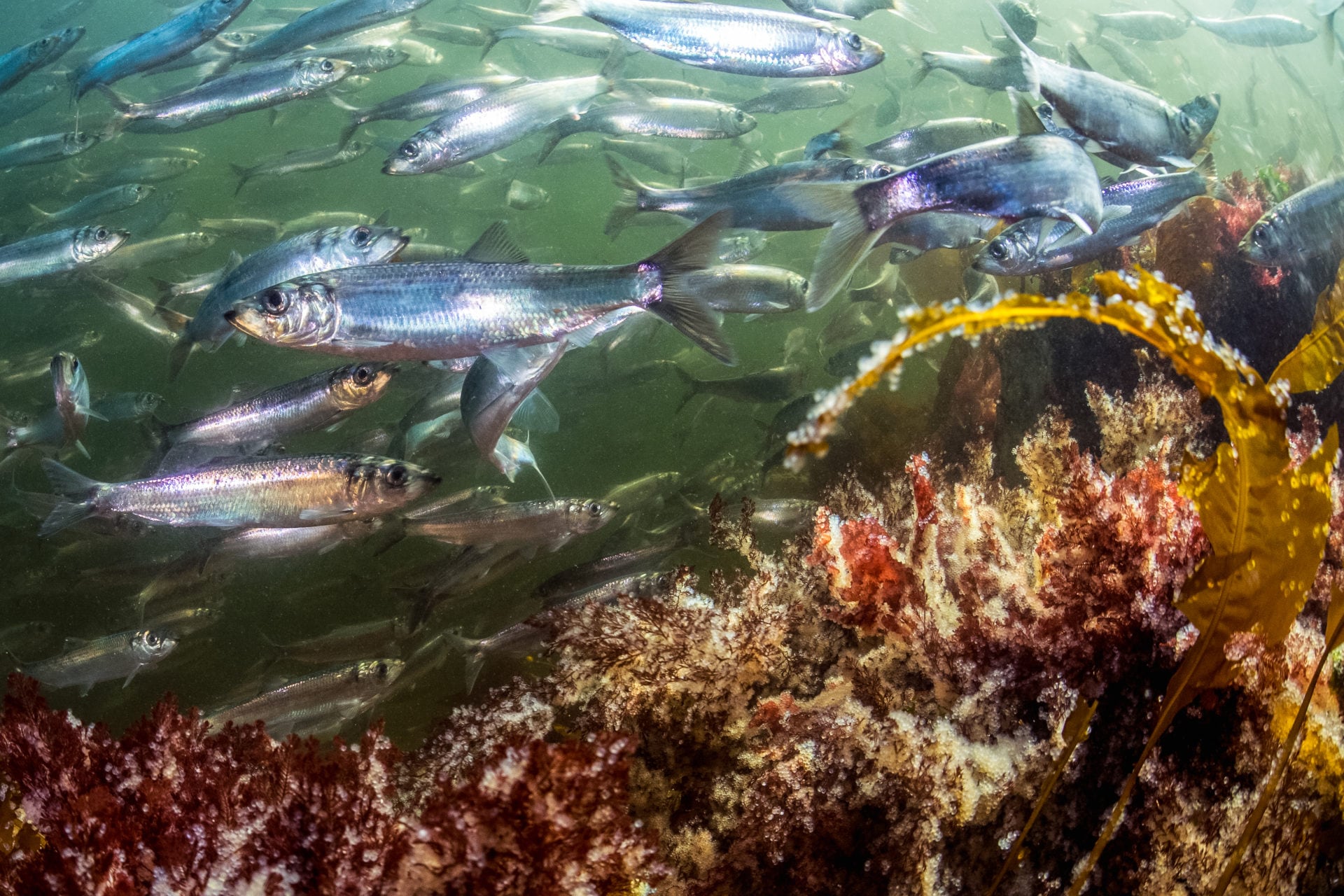
Herring during the 2018 spawning season in British Columbia. Photo: Pacific Wild


